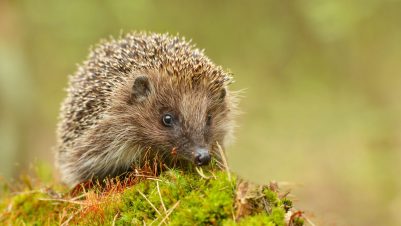THE illegal trade in wildlife
products has received much
publicity in recent months.
The poaching of elephants for ivory
and rhinos for their horns has been on
the front pages of many national
newspapers and news websites, and the
heirs to the British throne
have done much to raise
the profile of this damaging
and unsustainable animal
slaughter.
Whilst it is these large
iconic species that grab the headlines, a
huge number of other animals are also
at considerable risk and in danger of
serious decline without us even noticing.
One such group of animals is the
eight species of pangolins, four of
which are found in Asia and four in
Africa. Six of the species are now listed
as either “near threatened” or
“endangered” by the International
Union for the Conservation of Nature
(IUCN) with the other two currently
classified as of “least concern”.
Pangolins of the Old World occupy
a similar niche to the anteaters and
armadillos of the New World, preying
on termites and ants. They have
powerful claws with which they excavate termite mounds and long
sticky tongues for “hoovering” up the
insects. Specialised muscles seal their
nostrils and ears to prevent attacks from
the insects they are predating and a
highly-developed sense of smell helps
them to locate the nests.
Some pangolin species are arboreal
with prehensile tails whilst others are
primarily ground dwelling, constructing
underground burrows and nests in
which to sleep. They have few natural
enemies other than man, being covered
in hard keratinised scales and possessing
the ability to curl into a ball when
threatened. It is this natural reaction to
danger that makes them so easily
predated by humans.
So why are pangolins being killed?
The primary reason is for meat in both
Africa and Asia where it is considered a
delicacy, particularly in some
Vietnamese and Chinese cultures. In
addition, the scales are used in various
Asian medicinal products.
A paper recently
published in the
journal Frontiers in
Ecology and the
Environment gave an
indication of the scale
of the illegal trade in pangolins and
pangolin products.
From analysis of available records it
is estimated that there may be as many as 10,000 pangolins
seized annually by
customs officials world-
wide, with the total
number traded illegally
thought to be much
higher still.
And with pangolin
scales selling for £360
per kilo, twice what they
were worth a few years
ago, that trade is highly lucrative. So
much so that the IUCN suggest that
there is now evidence that African
pangolins are being targeted for the
intercontinental trade to Asian markets.
Pangolins are slow breeders with a
single offspring being born that remains
with the mother for three to four
months. The scales are soft at birth but
these begin to harden within a couple of days and the young
start to eat insects at
about a month of age.
Due to the slow
reproductive rate the
current level of slaughter is completely unsustainable
and CITES recognises this with all
Asian species being listed. This,
however, does not deter many poachers and smugglers even
though persistent
offenders have been
sentenced to up to life
imprisonment. There is
simply too much
money to be made.
Supply and demand
means that the trade is
likely to become even
more lucrative as disposable incomes in user countries
increase. Only by increasing public
awareness of the problem and through
educating people to the lack of
evidence for the medicinal benefits of
pangolin products can the demand be
reduced.
The IUCN is attempting to do this
and World Pangolin Day was celebrated
on 15th February 2014.






